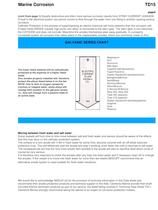
Catalog excerpts

Marine Corrosion The following is ar exlracl (rom the publication by MGDuff about marine corrosion. Clements Marine acknowledge past support trom MGDuft and permission to publish this sheet. "What really Is corrosion?" Corrosion (corro-zhun) n. to wear away; destroy gradually. (Oxlord dictionary). In brief, virtually all underwater corrosion is of an electro-chemical nature brought about by galvanic cells formed between parts of the SAME piece of metal. Measurable electric current (lows between these cells, one part of which is called the ANODE and corrodes away; and the other the CATHODE which does not corrode. All metals used in Boat and Ship Building are liable to corrosion. The more 'noble' metals (Monel, stainless steel and bronzes) being much less liable to corrosion than the 'base' metals, e.g. aluminium and ordinary steels. "I thought It was two metals reacting?" This is what causes corrosion to increase rapidly and become a major problem - even a danger. Two connected metals or metals which are alloys of dlflerent metals with differing potentials will set up a strong galvanic cell. The result - the more 'base' metal will corrode away rapidly."Is It really as serious as that?" The results of corrosion are well known but often unpredictable. On one vessel a rudder stock will wear through in a season, on another a similar part will last twenty years. Propellers may give many years service (though corrosion is slowly going on), but equally they may become badly corroded within a few months. Whilst this may be exceptional it is by no means uncommon to find propellers or shafts failing within one or two years. "What can I do to stop corrosion?" CORRECT SELECTION OF MATERIALS - of prime importance in the construction of craft. Metals should be selected to be as far as possible compatible with each other (close together on the potential table, page 2). Where this is not possible they should be isolated from each other. In particular, make sure that fastenings (including split pins) CORRECT TREATMENT OF MATERIALS - paints should be correctly selected and applied strictly in accordance with manufacturers' recommendations. Steelwork on rudders, skegs and fin/bilge keels require a good quality ANTI- CORROSIVE PRIMER before antiloullng Is applied (antifoullngs containing metallic particles of copper or CORRECT INSTALLATION OF ELECTRICS - to reduce the possibility of stray current leakage. Here are some specific recommendatlons;- (I) Use only high grade insulated wiring of suitable capacity. Undersize wires will cause resistance and consequent voltage drop, (il) Clip or support all wires at suitable intervals to prevent tatigue and eventual fracture, (iii) Use only corrosion-resistant terminals and connectors and make sure that all are clean and tight, (iv) Attach only the main battery leads to battery terminals, (v) Fit an isolating switch in the battery circuit, (vi) Ensure that all circuits are correctly fused, (vii) Keep all wiring, connections and junction boxes above the bilge area and away from other areas likely to be (vili) Make sure that additional electronic gear such as R/T, echo sounder, windspeed indicator, etc. Is all fitted in accordance with manufacturers' recommendations Ensure that polarity of connections Is correct and that each circuit is correctly fused. Electrical and electronic equipment is best fitted by a qualified marine electrician. CORRECT MAINTENANCE OF CRAFT - particularly paint coatings and electrical systems. Avoid the use of lead-based primers below the waterline on metal Always remember that NO metal used In Marine construction is corrosion free. However the above advice PLUS an M.G.Duff Cathodlc Protection system will ensure maximum protection. With cathodlc protection the metal to be protected Is made the cathode In the equivalent of an electrolytic cell. Only the sacrillclal anode wastes away. The most serious results of corrosion on GRP and wooden hulled vessels are usually when a small Item such as a split pin, fastening, or a major Item such as a propeller shaft tails after corrosion. At best this can be a source of annoyance; at worst the craft being out of commission until an expensive repair Is completed.
Open the catalog to page 1
Marine Corrosion TD15 page2 (cont from page 1) Equally destructive and often more serious corrosion results from STRAY CURRENT LEAKAGE. A fault in the electrical system can permit current to flow through the water from one fitting to another causing serious corrosion. Cathodic Protection is the process of superimposing an electro-chemical cell more powerful than the corrosion cell. A base metal ANODE (usually high purity zinc alloy) is connected to the stern gear. The stern gear in turn becomes the CATHODE and does not corrode. Meantime the anodes themselves wear away gradually. In a...
Open the catalog to page 2All Clements Engineering Ltd catalogs and brochures
-
Propeller
2 Pages
-
MARINE BEARINGS
2 Pages
-
Shaft Seals
2 Pages
-
MARINE SHAFTING ALLOYS
1 Pages
-
PROPELLER SPECIFICATIONS
2 Pages
Archived catalogs
-
Marine bearing
2 Pages
-
Rudder bearing system
2 Pages
-
Rudder tubes
2 Pages
-
Marine Shafting Alloys
2 Pages


















